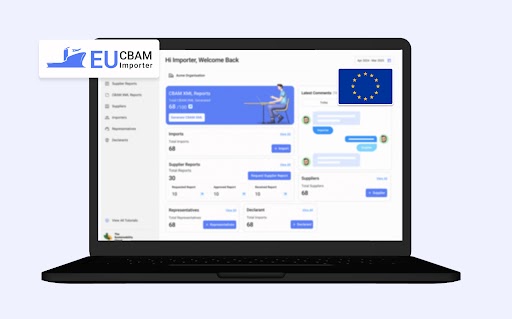The European Union’s Carbon Border Adjustment Mechanism (CBAM) reporting emphasises the accuracy of embedded emissions data during the production processes of CBAM products. Data management plays a critical role in following multiple guidelines for emissions data reporting for EU importers, who are the connecting link between the National Competent Authority (NCA) and suppliers outside the EU. The compliances mandate accurate data collection, and third-party data verification by the importers ensures accurate compliance. However, the amount of emissions data is massive, and it becomes challenging to process, manage, and account for it.
As per the EU guidelines for importers, steps must be followed to manage emissions data under the CBAM reporting. These rules are applicable to suppliers under both the CBAM implementation phases. Here is a look at the step-by-step guide for effective data management by EU importers under CBAM reporting:
1.Identifying CBAM goods in your products
The first step is to check Combined Nomenclature (CN codes) and identify the products that an importer imports from suppliers outside the EU. With the help of CN codes, importers will be able to know about products and will only focus on emissions data related to the items mentioned in the guidelines. This will help determine the scope of collecting emissions data for that particular product from the six categories under CBAM.
2. Collaboration for emissions data from suppliers
Collaboration between importers and suppliers must occur for emissions data sharing in the given template and format. Importers must be able to obtain and manage data on the installations’ direct emissions, indirect emissions from electricity consumed during the processes, and precursors.
3. Data accuracy and completeness
At this stage, importers must have all the required emissions data to ensure accuracy and completeness. The data must also include information about quantities of goods imported and embedded emissions per unit of goods. The importer must be able to maintain data hygiene and accuracy. This is an integral part of importers’ data management. Data must be ensured that it is not lost during the exchange process between importer and exporter.
4. Monitoring and tracking emissions data
Importers need to set up systems to track and monitor the emissions data for different goods under different CN codes. At this stage, traceable and auditable records of the origin of imported goods, production installations, and emissions data should be maintained.
5. Data verification and update
One of the best ways to manage data is to verify and update emissions data periodically. Data verification must be done by a third party at the behest of importers. The importer must screen emissions data and be prepared to align its data management system as per any policy update. Importers must also engage in data cross-checking and verification against multiple sources to maintain high accuracy.
6. Register with NCA
Importers must register with the National Competent Authorities (NCA) to declare the quantity of goods and their embedded emissions in the imported goods in the EU. All the documents must be submitted correctly to the NCA for registration before the actual report is filed with the EU. Importers can access the registry through the NCA of the Member State, where they are established. The registry helps manage data.
7. Quarterly report submission
After all these stages, importers must submit their quarterly CBAM reports via the CBAM Transitional Registry. The emissions data submission deadline should be noted as delayed submission is only allowed for a one-month period.
8. Data audit
Importers can perform an audit to assess data quality and identify potential discrepancies. CBAM data needs to be audited regularly for better data management.

Key factors for effective data management
There are at least three key factors for effective data management: automation, collaboration, and training. Effective data management highly depends on integrating emissions data tracking into existing ERP and bookkeeping systems. Moreover, close collaboration between operators and all communication channels is required for efficient data management. Eventually, adequate education on CBAM requirements and data collection must be provided to all staff members, as data management is a team effort.
How does TSC NetZero help in importer’s data management?
Accurate data collection and management are essential for verification and auditing. The most effective way to implement CBAM is to digitise emissions data, as the process is time-consuming and complex. Emissions data must be collected in a specific format, and managing and maintaining this large-scale data is tedious.
However, ensuring the accuracy of emissions data on such a large scale can be challenging. Product solutions like TSC NetZero’s CBAM reporting software can resolve all challenges related to becoming CBAM-ready and digitising the entire process with ease and efficiency. It offers hassle-free solutions to all challenges on a single platform.



